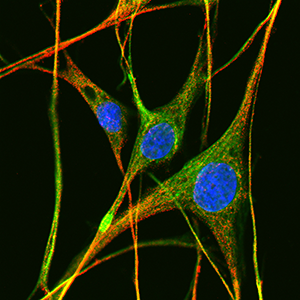 (EN: Peripheral Neuropathy)
(EN: Peripheral Neuropathy)
Die periphere diabetische Neuropathie (PDN) ist eine schwerwiegende Komplikation, die bei Diabetes mellitus Typ 1 und Typ 2 (T1D und T2D) sowie bei Fettleibigkeit beobachtet wird. Die Pathophysiologie dieser neurologischen Störung umfasst metabolische, vaskuläre und entzündliche Mechanismen.
Eine einheitliche Hypothese der verantwortlichen pathogenen Faktoren ist jedoch umstritten. PDN führt zu einer axonalen Degeneration peripherer Nerven und einer beeinträchtigten Regeneration, die mit strukturellen und funktionellen Veränderungen in endoneuralen und epineuralen Mikrogefäßen sowie in Schwann-Zellen einhergeht. Unsere aktuellen Projekte konzentrieren sich auf die Identifizierung metabolischer und entzündlicher Mechanismen von PDN, um neue Therapiestrategien zu entwickeln.
ROLLE DES EISENS IN DER ENTWICKLUNG DER PERIPHEREN DIABETISCHEN NEUROPATHIE (PDN)
Finanziert von der Deutschen Diabetes Gesellschaft (DDG) 934300-002
In Kooperation mit Prof. Dr. Matthias Blüher, Dr. med. Petra Baum, Dr. Maximilian Stockinger, Dr. Joanna Kosacka
Eisen ist ein essentielles, aber auch ein toxisches Metall. Zunehmende Untersuchungen zeigten einen Zusammenhang zwischen erhöhter Körpereiseneinlagerung und Diabetes mellitus. Die häufigste Komplikationsform des Diabetes mellitus ist die periphere diabetische Neuropathie (PDN), die zur peripheren Nervendegeneration mit strukturellen und funktionellen Veränderungen der Nervengefäße, der Nervenfasern und Schwannzellen führt. Ziel unseres Projektes ist es, die Rolle des Eisens in der Entwicklung der PDN bei Diabetes mellitus Typ 1 und 2, Adipositas und Metabolischem Syndrom auf neurophysiologische, morphologische und molekulare Ebene zu untersuchen.
